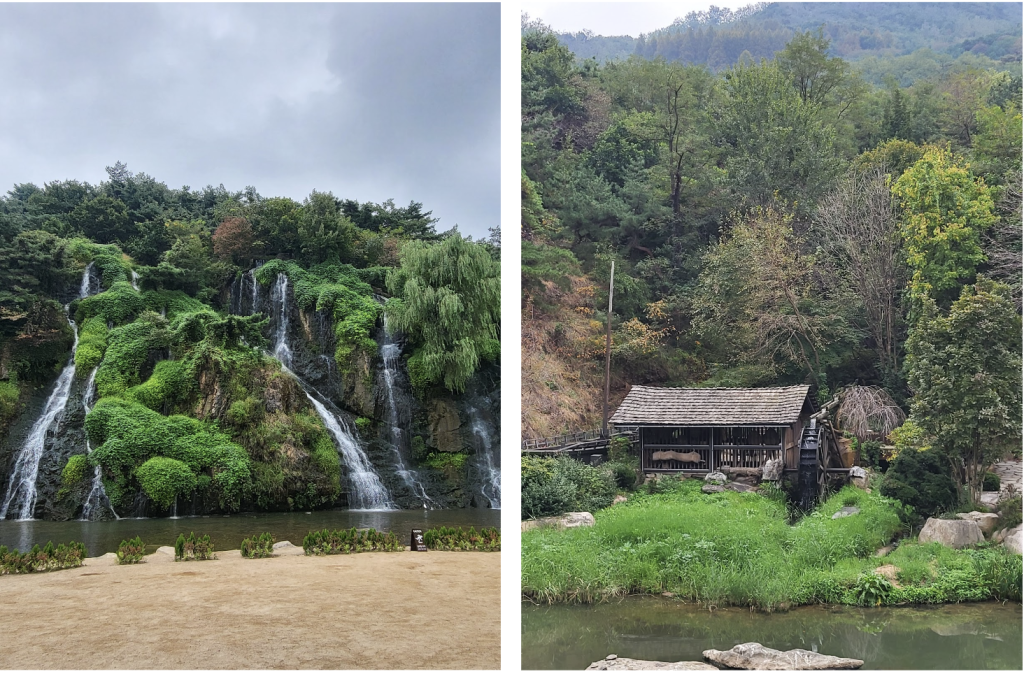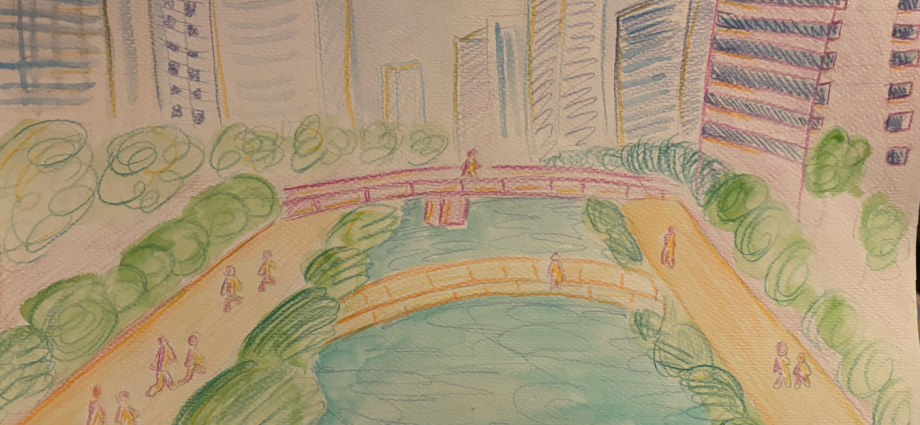Written by Barbara Gąsienica
Seoul, South Korea – a bustling megacity with over 10 million residents. Seoulites have been searching desperately for places to relax, unaware that the solution has been right there all along. The streams and reservoirs have been quietly waiting for their potential to be recognised.
Hongjecheon Stream and the nearby Cafe Pokpo don’t seem all that remarkable; they have no special historical meaning, yet visitors first see a tourist information office upon arrival. Why are tourist facilities placed next to an ordinary park and a café? What has caused ‘Café Pokpo’ to suddenly gain popularity on social media and travel blogs as a ‘trendy spot’ or ‘hidden gem’? Let’s explore what is special about Cafe Pokpo and how this location gives us a glimpse of what the future might hold for other riverbanks in Seoul.

The ‘Romantic Travel Spots in the City’ map presents Seodaemun Hongje Falls as a “cool sparkling flow of waterfalls, along the massive wall”, which “provides a sense of refreshment that harmonises with the changing seasons, displaying a beautiful landscape”. It is also promoted as “a healing destination despite being located in the heart of Seoul”. Cafe Pokpo, the warehouse-turned-cafe, is advertised as “a place where people can relax while admiring the waterfall”. It indeed sounds very peaceful and encouraging.
However, Hongjecheon Artificial Falls was first opened in 2011 and for over 10 years it was nothing more than that. It used to be just another park in a regular neighbourhood. Its surroundings aren’t that appealing either; around it are apartments, a hospital, a warehouse and a car park; and above it runs a highway. Such scenery seems to contradict the enthusiastic description of the ‘romantic travel spots map’, presenting a rather negative image. This is a common landscape in many parts of Seoul. Apart from the historically significant Han River and Cheonggyecheon Stream, most riverbanks in Seoul are primarily viewed as flood protection zones. Rather than being a place for the citizens to relax, their access is often limited by roads and barriers along the riverbanks. Although the 2011 renovation of Hongjecheon Artificial Falls allowed citizens to access the riverbank, the area still lacked a distinctive and inviting charm.
This problem of unutilised riverbanks is what Seoul’s Mayor Oh Se-hoon wanted to address through Seoul’s Waterside Emotional City Development Project. It is a series of urban restoration efforts designed to enhance the lives of citizens by transforming riverside areas into outdoor sports facilities and parks. Rather than simply changing the physical structure of the riverbanks, the idea is to reorganise the city to centre around water. The three pilot projects are in Dorimcheon, Jeongneungcheon, and Hongjecheon. Multiplier effects on other neighbourhoods’ historical, cultural, and economic assets are also expected, promoting a balanced development of all of Seoul’s districts (Seoul Metropolitan Government 2022, Seoul Metropolitan Government 2023).
Determined to see why Café Pokpo is so popular and who its visitors are, I headed to Hongjecheon. Deciding to visit on a quiet Tuesday afternoon, I expected to have the place all to myself. I couldn’t have been more wrong. Almost all of the indoor and outdoor tables were taken. As I got closer to the waterfall, I took note of the interesting demographic. There were a lot of foreigners, mainly young people in their 20s and 30s, admiring the view and taking pictures. There were also a lot of elderly Koreans enjoying the atmosphere. (Naturally, at that time, younger Koreans were likely at work rather than strolling near the waterfall.) I was surprised to see hospital patients resting near the waterfall. As it turned out, Orthopaedics Dongshin Hospital is right next to it and its patients often come with their visitors to relax by the waterfall.
When it comes to the onsite facilities there are the Hongjecheon Artificial Falls, Cafe Pokpo, the Tourist Infomation Centre, access to the Hongjecheon walking and cycling paths, a small library with study spaces and a traditional water mill display that provides a link with Korean Society’s historical relationship with water.

As I found out in the tourist information centre, the benefit of Cafe Pokpo is not only for its visitors but for the whole district of Seodaemun. Since Hongje Falls and Cafe Pokpo found themselves on the official maps and guided tours of the Seodaemun Tourist Information Centre, potential visitors of Cafe Pokpo are expected to not limit themselves just to a single attraction but visit most of the Seodaemun district’s attractions. For example, Seodaemun Independence Park and its Prison History Hall, Dongnimun Gate and Yonsei University. Seodaemun wants to promote a package of historical sites, educational and art venues, and cultural and natural landmarks.
Other tourist programs incorporate the Cafe Pokpo into guided tours like “Walking trip along the Honhjecheon stream” which is a free-of-charge guided walking tour offered in Korean, English, Japanese and Chinese that includes the waterfall in their itinerary. There is also a tour focusing only on the waterfall and the Ansan mountain. The tours are both in person (English) and self-guided (English and Chinese) with the possibility of renting an audioguide from the Seodaemun Tourist Information Centre. There is also a system of prizes for attendance. All tour participants receive a badge, a magnet, or a towel exemplifying the importance of gift-giving culture in Asian tourism promotion. It shows the willingness of local authorities to invest in the Waterside Emotional City Development Project, giving it as much attention as they give to palaces, museums and other tourist locations.
This effort goes beyond simply including Café Pokpo in tourist maps, preparing tours, and creating merchandise. The place is actively promoted through cultural events, featuring music and dance performances alongside traditional Korean music showcases. These events are heavily promoted on social media to boost Seodaemun and advance Café Pokpo’s ‘romantic and healing’ image.
However, despite the efforts, my take is that the place is far from what it’s setting out to be. Rather than being a peaceful oasis where people can take a city break and do yoga or meditation, it’s still a loud, bustling place. With the constant rush of the waterfall and the large crowds it attracts, this place can get extremely noisy. The sound level is comparable to that of a busy market. Though the waterfall creates a natural impression, despite being man-made, everything around it—except for the waterfall and the mill—resembles a typical neighbourhood. The most unpleasant features are the highway looming overhead and the parking lot nearby. Therefore, the peaceful and natural image of Cafe Pokpo can be misleading.
Nevertheless, the regeneration project succeeded in place-making, because it seems to have become a popular site for residents. At the very least, it transformed an old warehouse into a popular cafe. More than that, it has attracted tourism and revitalised the local economy. Due to its initial success, Cafe Pokpo has even been used as a springboard for the Waterside Emotional City Development Project by hanging its promotional banners near the waterfall and providing space for the 2024 Water Seoul International Conference hosted by the Seoul Metropolitan Government. Cake Poko also contributed to the sustainable development goal of the Waterside Emotional City Development Project as its proceeds are used as scholarships for local students thus creating an additional benefit for its residents. Therefore, the regeneration effort has made a positive contribution to the area.
The project made something out of nothing by promoting a ‘romantic and healing natural site’ in the city centre. Although I don’t entirely agree with this recognition of Cafe Pokpo as ‘a healing natural site’, it managed to sell this perspective well. It attracts tourists and creates a much-needed green space for residents. It would be interesting to see whether the project will contribute to the wider Seodaemun area as expected, or if it just affects the surroundings of Cafe Pokpo. However, with place-making achieved so far, I remain optimistic.
Edited by Age Steenbreker, Illustrated by Camilla

